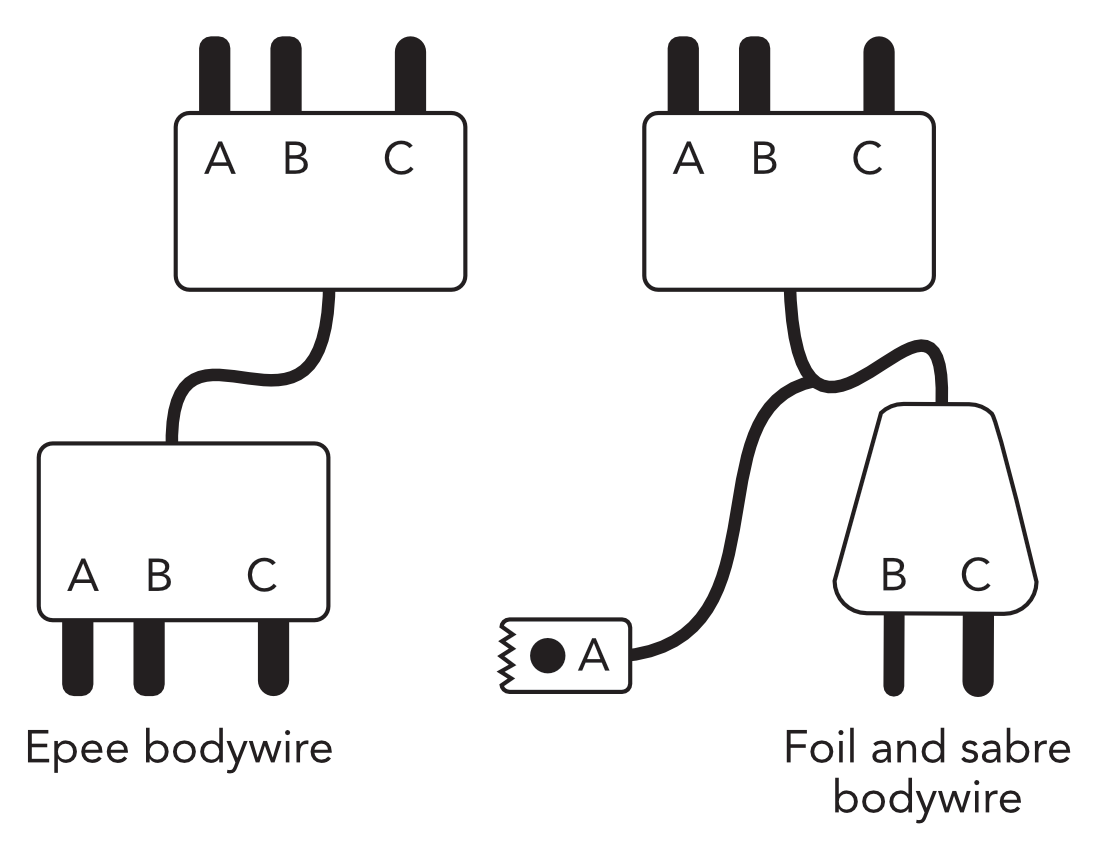
Mountains Fencing Club Inc.
powered by TidyHQHow the weapons work
How the weapons work
Each of the weapons has current running through it from the scoring box. The bodywire carries this current through three separate and independent lines – called A, B and C. The C line is always connected to ground. A and B are used by each of the weapons in different ways to complete circuits for scoring.

Epee
The blade has two wires – one from the A line and one from the B line. The epee tip is a switch at the end of these wires. In its resting state the switch is open and there is no circuit between the A and B line. When the tip is depressed it closes the switch and completes a circuit, allowing current to flow. The scoring box registers this currrent and lights for a touch. As the bell guard is not target, touches on the guard should not register. When the tip is depressed on the bell guard, the current flows into the conductive bell guard and through its C line to ground, bypassing the A and B lines in the blade. With no change in the A–B circuit, no touch registers. Touches which register on the bell guard indicate a dirty bell guard (impairing its conductivity) or a fault in the equipment.
Foil
The blade has one wire – from the B line. Current flows up the wire to the tip, then down the blade and back through the C line to ground. The lamé is connected to the A line. The tip is a switch connecting the B and C lines. In its resting state the switch is closed, allowing the circuit to be completed. When the tip is depressed the switch opens and breaks this circuit. If the tip is depressed on the opponent’s lamé, current flows from the weapon, into the opponent’s lamé and out through their A line (alligator clip), completing a new circuit to the scoring box, where it is registered as a touch. If the tip is depressed on a non-target (ie non-conductive) area, the circuit is broken and the scoring box registers an off target light. If the tip is depressed on the opponent’s guard, a new circuit is completed through the opponent’s C line to ground, replicating the foil’s resting state, and no touch registers. Foil blades must be taped to insulate the blade from the opponent’s lamé. If a foil blade is inadequately taped, or not taped at all, when the tip is depressed on target, if the opponent’s lamé is in contact with the uninsulated blade, a new circuit will be completed back through the attacker’s blade and their C line to ground, replicating the foil’s resting state, and thus no touch registers.
Sabre
The sabre has no wires. Instead, the blade itself acts as a closed switch between the B and C lines, allowing current to flow through the sabre at all times. The lamé is connected to the A line. When the blade touches the opponent’s lamé, a circuit is completed between the fencer’s B line and the opponents A line. The scoring box registers that the circuit has been completed and lights for a touch. If the blade touches a non-target area (ie a non-conductive area), no new circuits are completed or interrupted and so nothing is registered on the scoring box. If the circuit running through the sabre is completely interrupted (for instance by the sabre being unplugged or breaking) the scoring box will notice this and a white light will come on.
Info sheets to download
How the electric weapons work (the info above, on a handy A4 sheet)
Basic testing of bodywires and weapons
Troubleshooting on the piste – epee
Troubleshooting on the piste – foil
Troubleshooting on the piste – sabre
More info on troubleshooting on the piste
This video by Michael Mergens (author of The Care and Feeding of all things Fencing) is also an excellent resource.
